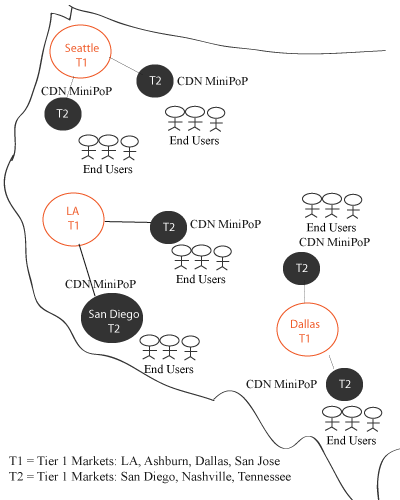The CDN market is one of the most innovative verticals in all of tech. Many of the infrastructure pieces that make up the CDN, such as bare-metal hardware and open source software have enabled CDNs to become creative in the development of new services and features, especially in the areas of performance, security and video streaming. For example, bare-metal commodity servers + SSD drives + Apache Traffic Server + NoSQL database have given startup CDNs the ability to compete against much larger CDNs in the areas of delivery performance and reporting.
However, data center and co-location facilities have lagged, and rarely have they given CDNs the ability to create innovate offerings, that is until now. EdgeConneX and similar companies like 365 Data Centers are pioneering a new trend which we’ll call the “Last Mile Edge PoP” in the Tier 2 markets like San Diego and Memphis, not to be confused to the Tier 2 data center classification.
Hybrid CDN Network Footprint – SuperPoP + MiniPoP

Tier 2 regions like Nashville are under-served, and rarely do you find an Equinix like facility in those regions, compared to a San Francisco or Los Angeles, which might have “between 60 to 70 data centers” in close proximity. 365 Data Centers is seeing an increase in demand not only from broadband users requesting content hosted in their data centers, but also from content companies that want to place their content to the edge of the network. 365 Data Centers is going as far as selling their data center facilities in larger markets, in order to build more facilities in the under-served Tier 2 markets. How does impact CDNs? SuperPoP Architecture. Over time, CDNs are likely to go the way of hybrid network footprint architecture of SuperPoP + MiniPoP.

